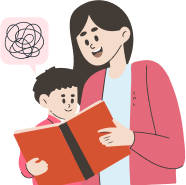You might have asked your child to write a few lines after reading a book and then wondered, Does this help them? It does. Writing can play an important role in building their reading confidence. When your child writes about what they read, they begin to make connections between ideas, deepen their understanding, and remember details more clearly.
Writing tasks give young readers a chance to slow down and process the text. Research shows that reading and writing fluency together explained about 50% of the variation in reading comprehension scores, showing a strong link between writing skills and reading success.
In this post, you’ll discover simple, practical ways to weave writing into your child’s reading routine. You’ll learn why it matters, how it supports their growth, and how just a few minutes of writing after reading can deepen their enjoyment and boost their confidence.
TLDR
-
Writing about what your child reads strengthens their reading skills by deepening their comprehension, reinforcing vocabulary, and boosting fluency.
-
Research shows that combining writing with reading improves reading comprehension by about 50%.
-
Simple writing activities, such as story summaries, character diaries, and word journals, can make reading more engaging and effective for young learners.
-
These activities help children connect ideas, build critical thinking skills, and increase retention, while making reading a more enjoyable and active experience.
What Does “Writing in Reading” Actually Mean?
For young learners, writing in reading means writing about what they read. That could be a short reflection, a summary, or even a few lines. These writing acts help kids think about the text, make sense of it, and remember it better. It’s not about full essays, it’s about simple writing that turns reading into active thinking.
When your child combines writing in reading this way, they begin to:
-
Responding in short sentences to a story or chapter, such as their favourite part or a question they have.
-
Writing simple explanations or reflections about what they read, such as describing characters, setting, or plot.
-
Creating mini versions of the text—a summary, an alternate ending, or a letter to a character.
-
Writing a few thoughts to connect reading to their own life or day, making reading feel meaningful.
Now that we know what 'writing in reading' means, let's take a closer look at how writing actively supports and enhances reading skills.
Also Read: Kindergarten Reading Tips for Parents
How Does Writing Support Reading?

Writing isn't just about putting words on paper; it's a powerful tool that helps your child become a better reader. When your child writes about what they read, they actively engage with the text, making connections and deepening their understanding. This process strengthens their reading skills in meaningful ways.
Here’s how writing supports reading:
-
Improves Comprehension: Writing about a story forces your child to think critically about the content, helping them grasp the main ideas and details more clearly. This active engagement makes it easier for them to understand and remember what they've read.
-
Enhances Fluency: Regular writing practice reinforces language patterns and structures, making reading smoother and more automatic over time. As your child becomes more comfortable with writing, they also become more fluent readers.
-
Strengthens Vocabulary: Writing encourages your child to use new words, expanding their vocabulary and improving their ability to understand and use language effectively. A richer vocabulary enhances their reading comprehension and expression.
-
Boosts Retention: The act of writing helps solidify information in your child’s memory, making it easier for them to recall and apply what they've read. This improved retention supports better understanding and recall during reading activities.
-
Encourages Reflection: Writing prompts your child to reflect on the text, fostering a deeper connection and personal engagement with the material. This reflective process enhances their ability to analyze and interpret what they read.
By incorporating writing into your child's reading routine, you're providing them with a valuable tool to enhance their reading skills and overall literacy development.
Now that we’ve explored how writing can support your child’s reading, let’s look at some fun and engaging writing activities that will make learning even more enjoyable and impactful.
Also Read: Understanding the Simple View of Reading Model
Fun Writing Activities to Boost Your Child's Reading Skills

Writing is a powerful tool that can significantly enhance your child’s reading skills in numerous ways. It helps them think more deeply about what they read and connect ideas in a way that makes the material stick.
Here are some fun and engaging writing activities that can help your child become a more confident reader:
1. Phonics Integration
For younger learners in early elementary (K-1), teach letter-sound correspondences by having them write the letters as you say the sounds. You can start with simple consonant-vowel-consonant (CVC) words like "cat" or "dog."
How it enhances reading: This activity helps children connect the sounds to the letters, which is essential for both decoding (reading) and encoding (writing). Writing the letters as they hear the sounds reinforces the connection between speech and writing, improving reading fluency.
Use colorful letter cards or a whiteboard to make this activity interactive. You can also have your child sound out and write the letters to form words, making it a fun game that makes the activity more engaging and hands-on.
2. Phonics Story Writing
For early learners, create a simple story where your child uses their phonics knowledge to write words. Ask them to write a short story using simple words with the letter sounds they’ve learned.
How it enhances reading: Writing a story using phonics reinforces the connection between sounds and letters. It helps children practice both decoding and encoding, which are crucial for developing reading fluency.
Making up their own stories allows children to feel a sense of ownership over their writing and helps them apply what they’ve learned in a creative way.
3. Story Summaries
After reading a story, ask your child to write a summary of the main events or what happened in the story. This exercise helps them focus on the key points of the text and understand the narrative flow.
How it enhances reading: Writing a summary forces your child to think critically about what they read, helping them remember the most important details. It encourages them to look at the text as a whole, improving their overall comprehension and memory.
You can make it even more fun by allowing your child to create a "comic strip" version of their summary or draw their favourite scene from the story. This gives them the chance to express their understanding creatively.
4. Character Diaries
Have your child pick their favourite character and write a diary entry as if they were that character. What would the character be feeling after a big event? How would they describe the world around them?
How it enhances reading: This activity helps your child dive deeper into the emotions and motivations of characters, which improves their ability to analyze texts. Understanding characters actions and feelings also strengthens comprehension and empathy, essential for reading complex texts.
Encourage your child to think about how the character’s experiences might match their own. This connection makes the character’s journey more personal and engaging, encouraging your child to care more about the story.
5. Create Alternative Endings
After reading a story, ask your child to rewrite the ending or imagine a new twist. They could change the story’s outcome or create a situation where a different character makes a different choice.
How it enhances reading: This activity encourages your child to understand the structure and how different events lead to specific outcomes. It also allows them to practice creative thinking while improving comprehension by making them think critically about how the story could have unfolded differently.
Children love to use their imagination. Allowing them to "play" with the storyline encourages them to engage with the material in a fun and creative way, while still reinforcing the lessons from the original text.
6. Word Journals
Create a word journal where your child writes down new words they come across while reading. After noting the word, they can use it in a sentence or even make up a story using several of the words.
How it enhances reading: This activity strengthens vocabulary recognition, which is crucial for reading comprehension. When children regularly encounter and use new words, they expand their understanding of the language, making it easier to decode unfamiliar words in future reading.
Make it interactive by asking your child to illustrate the words or find words that rhyme with them. This makes vocabulary building a fun and creative part of reading.
7. Picture Story Writing
Provide your child with a series of pictures, and ask them to write a story based on the images. This could be a set of illustrations, photographs, or even pictures from a magazine.
How it enhances reading: This activity helps your child understand how stories are structured, including their beginnings, middles, and endings, by using visual cues. It also enhances their ability to craft a coherent narrative and sequence events, which supports reading comprehension.
Children enjoy using their imagination to create stories from pictures. You can also turn this into a game by giving them a time limit or making it a "story challenge" to create the most exciting adventure possible.
8. Word Association Writing
Ask your child to choose a set of words from their reading and write a short story using these words. For example, if they read about a forest, they could write a story using words like “trees,” “animals,” and “adventure.”
How it enhances reading: This activity builds strong connections between vocabulary and context. It helps your child understand how words fit together to create meaning, which improves their reading comprehension. It also allows them to practice using new words in the correct context.
Word association makes the learning process feel like a fun puzzle. You can encourage friendly competition by seeing who can come up with the most creative or fun story using the words.
9. Collaborative Story Writing
Have your child collaborate with a friend or sibling to write a short story together. They can take turns writing sentences or paragraphs, building on each other's ideas.
How it enhances reading: Collaborative writing builds teamwork skills and encourages children to think critically about the flow of a story. Working together also gives them the chance to discuss the text, further developing their comprehension.
Children love collaborating with others, especially if they can share their ideas. This activity makes writing more social and less solitary, adding a fun element to their reading and writing practice.
These writing activities are not only fun but also powerful tools to help your child improve their reading skills. By writing about what they read, your child gains a deeper understanding of the text, builds stronger vocabulary, and becomes more confident in their ability to read and write effectively.
The key is consistency; try to include at least one activity regularly to make reading and writing feel like an exciting, ongoing adventure!
Also Read: Decoding in Reading: Strategies, Examples, and Real-World Solutions
Conclusion
Writing plays a crucial role in enhancing your child’s reading skills by helping them engage more deeply with texts. When children write about what they read, it improves their comprehension, reinforces vocabulary, and encourages critical thinking. From writing summaries to creating alternative endings, these activities not only make reading more enjoyable but also boost confidence and understanding.
If you’re looking for a more structured, interactive approach to improving your child’s reading and writing skills, FunFox offers online tutoring programs. FunFox’s Readers Club is designed to help children develop strong foundational reading skills through engaging, small-group lessons. With the FunFox Way, your child will receive personalized support to make reading and writing enjoyable and effective for young learners.
So, why wait? Register for a free class today and discover how FunFox can help your child improve their reading and writing skills.
FAQs
1. Does teaching writing skills actually improve reading?
Yes. Explicit instruction in writing processes, spelling, sentence construction, text structure, paragraph organization, and genres also boosts reading fluency, accuracy, and comprehension across grade levels.
2. How does writing support reading fluency and decoding?
Writing engages spelling and sentence formation, reinforcing knowledge of phonics, morphology, and syntax. That deeper cognitive connection strengthens word recognition, reading speed, and fluency
3. Should teachers use writing-only instruction to teach reading?
No. Writing-rich instruction should complement strong reading instruction, not replace it. Both reading and writing support each other most effectively when integrated thoughtfully
4. What does research say about writing’s impact on reading comprehension?
Studies, including a meta‑analysis by Graham & Hebert (2010), show that when students write about texts they’ve read through summaries, analyses, note‑taking or question generation, they improve reading comprehension more than by just reading or rereading alone.
5. How does questioning within writing promote active reading?
Embedding guiding questions, such as asking “what does this paragraph imply?” helps readers pause, reflect, and anticipate meaning. Studies show in-text questions (e.g. in textbooks) significantly improve comprehension and recall.















